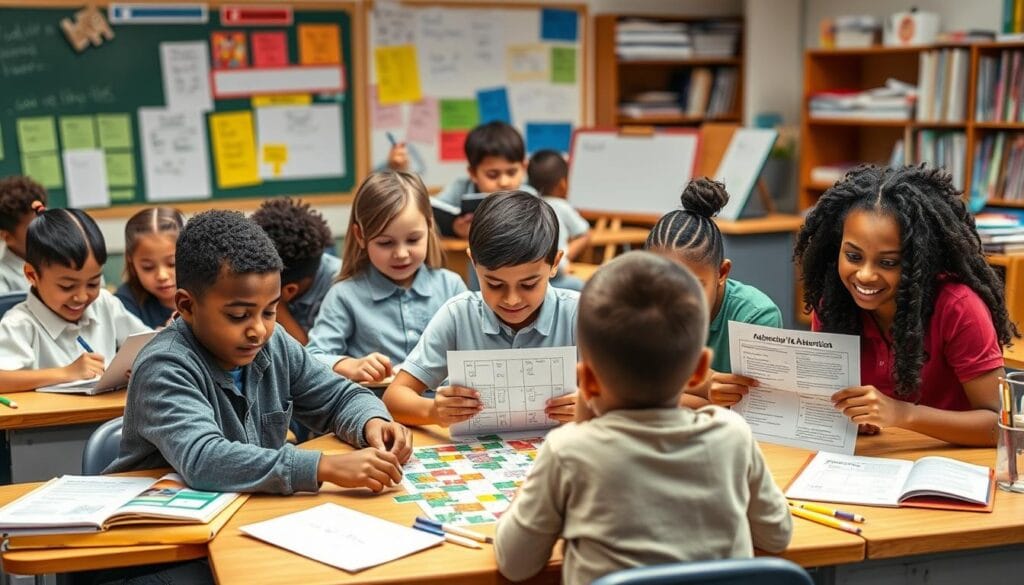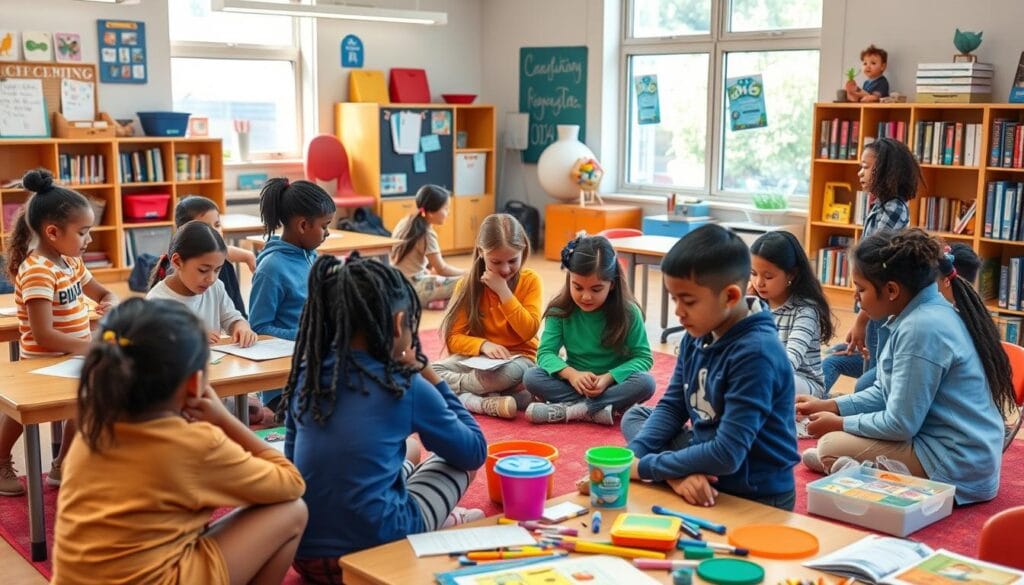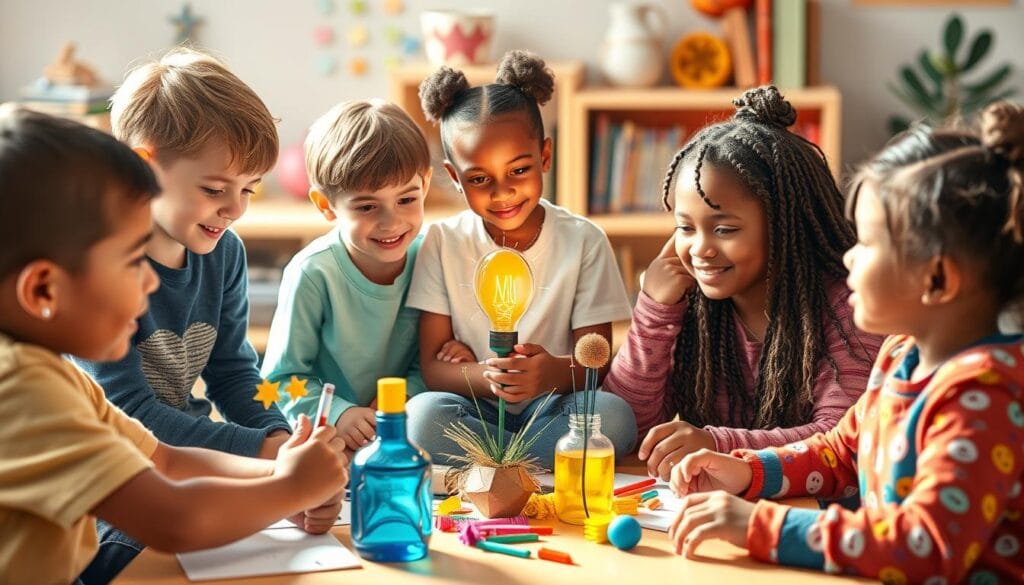How to Effectively Identify and Support Gifted Students?
It’s important for teachers and parents to spot and help gifted students. These kids have special talents that need special care to grow. Knowing how to find and support them helps them reach their highest potential.
فهرس المقالة
Understanding Characteristics of Gifted Students
Gifted students stand out for their sharp minds and talents. But they have more to offer than just good grades. Knowing what makes them special helps teachers, parents, and everyone else understand them better.
Cognitive and Behavioral Traits
These students solve problems quickly and learn fast. They love to learn new things and ask lots of questions. Sometimes, they get bored in class because the work is too easy.
Social and Emotional Characteristics
Gifted students are often very sensitive and caring. They make deep connections with others who share their love for learning. But, they might find it hard to fit in with their classmates.
Common Misconceptions About Giftedness
Many people think gifted students always do well in school. They believe giftedness is something you’re born with and never change. But, gifted students can struggle in school too. It’s important to clear up these myths to support them better.
“Giftedness is not just about test scores or academic achievement. It’s about the unique way these students think, feel, and experience the world.”
Early Signs of Academic Giftedness in Children
It’s key to spot early signs of academic giftedness in kids. This helps them get the support they need to grow. Knowing the signs helps parents and teachers help these students reach their goals.
Young gifted kids often talk early and have a big vocabulary. They understand grammar well and remember lots of things quickly. This shows they are learning fast.
These kids love to learn and ask lots of questions. They get new ideas fast and learn quickly. This makes them stand out from their friends.
- Early and advanced language development
- Exceptional memory and rapid learning
- Intense curiosity and a thirst for knowledge
- Advanced problem-solving and critical thinking skills
- Heightened sensitivity and emotional intensity
Every child is different, and giftedness shows in many ways. But spotting these signs early helps us support these students. This way, we make sure they grow and succeed.
“The essence of giftedness is not what children know, but how they think.”
– Stephanie Tolan, author and educator
Assessment Methods and Identification Processes
Finding and helping gifted students needs a detailed assessment process. It’s more than just tests. Good methods use different ways to see all of a student’s skills and potential.
Standardized Testing Approaches
Standard tests, like IQ tests, show a student’s smart side. They check verbal, math, and spatial skills. But, remember, tests alone can’t fully show if a student is gifted.
Portfolio-Based Evaluation
Portfolio assessments let students show off their many talents. They collect work like writing and science projects. This way, teachers see a student’s full range of abilities and interests.
Teacher and Parent Observations
Teachers and parents’ views are key in finding gifted students. They see students every day. They notice special talents and interests that tests might miss.
Using these methods together helps teachers really understand a student’s gift. They can then give the right support and learning experiences.

“The true measure of giftedness lies not only in test scores, but in the ability to think creatively, solve complex problems, and express one’s unique talents.”
Creating an Enriched Learning Environment
Creating a rich learning space is key for gifted students to grow. It means using enrichment programs, advanced curriculum, and differentiated instruction to push their minds. This helps them reach their highest potential.
Hands-on, project-based activities are vital. They spark critical thinking, problem-solving, and creativity. Gifted students love diving deep into complex topics and seeing how they apply to real life.
Also, giving students access to a wide range of resources is important. This includes special books, educational games, and online platforms. It helps meet the diverse interests and learning styles of gifted students. This makes the classroom a lively and engaging place for everyone.
Effective differentiated instruction is another key part. It lets teachers adjust the curriculum and teaching methods to fit each student’s needs. This way, every student gets the right challenge and support.
Lastly, building a supportive classroom culture is essential. It encourages gifted students to work together, share ideas, and learn from each other. This creates a sense of community and helps everyone grow intellectually.
By using these strategies, teachers can make learning exciting for gifted students. They provide the right resources, challenges, and support. This helps students succeed academically and personally.
Helping Gifted Students Through Differentiated Instruction

It’s important to understand the special learning needs of gifted students. Differentiated instruction helps meet these needs. It lets educators unlock the full potential of these students.
Curriculum Modification Strategies
Gifted students need more challenging content to stay engaged. Effective strategies include:
- Accelerating the pace of instruction to match their rapid comprehension
- Incorporating advanced, in-depth exploration of topics that align with their interests and abilities
- Providing opportunities for independent study and advanced research projects
These methods not only meet their intellectual needs but also build a love for learning.
Personalized Learning Plans
Personalized learning plans are key for gifted students. They focus on:
- Identifying their unique strengths, interests, and learning preferences
- Setting individualized goals and learning objectives
- Implementing targeted interventions and enrichment activities
- Regularly monitoring progress and adjusting the plan as needed
These plans tailor the learning experience to their needs, helping them thrive.
Advanced Project-Based Learning
Project-based learning (PBL) is great for challenging gifted students. Advanced PBL lets them:
- Explore complex, real-world problems in-depth
- Collaborate with peers on innovative solutions
- Showcase their exceptional critical thinking and problem-solving skills
Advanced PBL experiences meet their needs for differentiated instruction and personalized learning.
Using differentiated instruction is crucial for gifted students. By modifying the curriculum and creating personalized plans, educators can create a rich learning environment. This environment sparks the passion and potential of these exceptional learners.
Addressing Social-Emotional Needs
Gifted students face special challenges that need special help. They need support to succeed and feel valued. This support is key for their future and for fairness in education.
Perfectionism and Stress Management
Gifted students often aim too high, leading to stress and worry. It’s important for teachers and parents to help them find ways to manage stress. This includes teaching them to see success in a balanced way.
Peer Relationships and Social Integration
It can be hard for gifted students to connect with others. They might feel alone or not understood. Creating welcoming places where everyone is valued helps them make friends and feel accepted.
Emotional Sensitivity and Counseling Support
Many gifted students feel things deeply, which can be tough. Giving them access to counseling helps them deal with their feelings. It builds their strength and keeps their self-worth high.
By focusing on the social-emotional needs of gifted students, we can help them do well in school and life. Using a whole-person approach is a big step towards fairness in education. It lets these students reach their highest potential.

| Social-Emotional Challenges | Supportive Strategies |
|---|---|
| Perfectionism | Stress management techniques, balanced perspective on achievement |
| Peer Relationships | Inclusive environments, fostering empathy and social-emotional skills |
| Emotional Sensitivity | Counseling services, emotional support systems |
Implementing Acceleration and Advanced Programs
Gifted students can greatly benefit from accelerated learning and advanced programs. These opportunities provide the intellectual challenge they seek. They help these students reach new heights and fully develop their talents.
Grade-Level Acceleration Options
Grade-level acceleration is a great strategy. It lets students skip ahead a grade or more. This is especially helpful for those who have already mastered their current grade’s content. It keeps them engaged and ensures they continue to learn and grow.
Subject-Based Advancement
Subject-based advancement is another option. It allows gifted students to take classes or pursue subjects at a higher grade level than their peers. This targeted approach lets them dive deeper into areas they’re passionate about or excel in.
Enrichment Activities
- Hands-on workshops and project-based learning opportunities
- Participation in academic competitions and challenges
- Exposure to guest speakers and field trips in areas of interest
- Extracurricular activities that foster creativity and problem-solving
These enrichment activities add to the core curriculum. They give gifted students a chance to explore their interests, work with peers, and develop critical thinking and leadership skills.
| Acceleration Option | Benefits | Considerations |
|---|---|---|
| Grade-Level Acceleration |
|
|
| Subject-Based Advancement |
|
|
| Enrichment Activities |
|
|
By using a mix of these options, schools and parents can help gifted students reach their full potential. This empowers them to excel academically, socially, and emotionally.
Supporting Twice-Exceptional Students
In the world of gifted education, a special group is often overlooked: twice-exceptional students. These students have both amazing abilities and learning challenges. They need support that fits their unique needs to reach their full potential and ensure fairness in education.
Twice-exceptional students, known as “2e,” have a mix of strengths and weaknesses. They might show off their advanced thinking, creativity, and problem-solving skills. Yet, they also face learning disabilities, attention issues, or other challenges. It’s important to recognize and support their dual exceptionality to provide the right education and resources.
Identification and Assessment
Finding twice-exceptional students is the first step. Standard tests might miss their special needs. A thorough evaluation, including cognitive tests, achievement tests, and feedback from teachers and parents, is key. It helps find each 2e student’s unique strengths and challenges.
Tailored Instructional Approaches
After finding them, twice-exceptional students need a mix of gifted education and support for their learning differences. Tailored instruction, focusing on educational equity, helps them succeed. Using strategies like curriculum compacting, flexible grouping, and assistive technologies can help 2e learners reach their goals.
Social-Emotional Support
Twice-exceptional students also need help with their social and emotional well-being. They might feel more sensitive, perfectionistic, and face social challenges. Counseling, peer support, and a caring school environment can help them feel accepted and strong.
Supporting twice-exceptional students means using a variety of approaches. It’s about recognizing their strengths and meeting their learning needs. By doing this, educators can help these students succeed academically and personally. This makes education more inclusive and fair for everyone.
| Characteristic | Description |
|---|---|
| Advanced Cognitive Abilities | Twice-exceptional students often display exceptional reasoning, problem-solving, and creative thinking skills. |
| Learning Disabilities | These students may struggle with specific learning challenges, such as dyslexia, ADHD, or processing disorders. |
| Asynchronous Development | Twice-exceptional learners may exhibit uneven development, with advanced abilities in some areas and significant challenges in others. |
| Social-Emotional Needs | Heightened sensitivity, perfectionism, and social difficulties are common among twice-exceptional students. |
Conclusion
It’s very important for educators, parents, and the community to support gifted students. We need to understand what makes them special and find ways to help them early on. This way, every child can reach their highest potential.
Creating a rich learning environment is key. We must tailor lessons to meet their needs and take care of their social and emotional well-being. Programs that speed up learning and support for students with special needs are also crucial.
Your dedication to gifted students is vital. By supporting them, we help them grow and make a big impact on the world. By focusing on their development, we open doors to their incredible talents and help them shine.
FAQ
What are the key characteristics of gifted students?
Gifted students show advanced thinking and behavior. They have high intelligence, learn quickly, and solve problems well. They also have unique feelings, like being very sensitive and caring about fairness.
How can I identify early signs of giftedness in children?
Look for signs like talking early, remembering a lot, and learning fast. They might focus a lot and ask lots of questions. Paying attention to these signs is important.
What are the different methods used to assess and identify gifted students?
There are many ways to find gifted students. Tests, looking at their work, and teacher observations are common. Using a mix of these methods is best.
How can I create an enriched learning environment for gifted students?
Create a special learning space for them. Use challenging materials and projects. Make sure the lessons match their interests and abilities.
What are some effective differentiation strategies for teaching gifted students?
Tailor lessons for them by changing the curriculum and making plans just for them. Use projects that are more complex and interesting. This helps them learn at their own pace.
How can I address the social-emotional needs of gifted students?
Understand and help with their special challenges. This includes helping with perfectionism and making friends. Give them ways to handle stress and support from peers.
What are the benefits of acceleration and advanced programs for gifted students?
Programs that move them ahead in school are great. They get to learn more and faster. This lets them explore their interests deeper.
How can I support twice-exceptional students who are both gifted and have learning disabilities?
Help them by identifying their needs early and providing special help. Make sure they get the right support for both their gifts and challenges. It’s important to make sure they are treated fairly.






